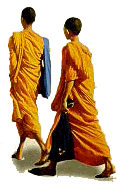The Teachings of Shitou Xiqian
Shitou's
teachings are seen in two sources: the biography and recorded sayings from the
Song histories, and two long discursive poems which summarize his distinctive
approach to chan practice. The numerous conversations with his students focus
thematically on statements of emptiness, thusness (non-duality), and Buddha-nature
(tathagata-garbha) theory. They conform generally to the mainstream chan literature
disseminated during the Song period. The numerous references to Huineng and his
temple in Cao Xi indicate a strong intention to conform to the lineage of the
Southern School, which was in the process of establishing itself as the dominant
chan movement during Shitou's lifetime. Repeated references to sutra study and
mention of a work by the 5th-century Chinese dialectician Sengzhao show that Shitou
had a strong knowledge of Buddhist literature and philosophy. Of great importance
is Shitou's lengthy acknowledgment of "the mind is Buddha" teaching,
which was also popular with other chan masters in the 8th century, being mentioned
in the Record of Mazu as well as in the Platform Sutra. A direct statement of
Buddha-nature theory, it identifies the human mind in its pristine or undefiled
state as synonymous with the enlightened mind of Buddha.
Two longer poems
attributed to Shitou present new perspectives to our understanding of his personality
and career as a chan master. In the Grass Shack Song we see him newly arrived
on South Mountain, living in the meditation hut he built for himself on top of
a large flat rock. The poem is actually a restatement in Buddhist terms of a Taoist
archetype, namely that of the hermit or "mountain sage" who has forsaken
the conflicts and business of social existence to pursue a spiritual path. This
is a common topos in Tang-period poetry, translated in this case to the realization
of the universal Buddha-nature. The possibility of solitary meditation in a mountain
wilderness seems to have largely disappeared with the gradual establishment of
the chan monasteries and the increasing regimentation of monastic life, so we
might think that the monks of the Song period may have looked back nostalgically
to a more individualistic era. In any event, the poem's obvious enthusiasm for
a do-it-yourself Buddhist lifestyle is, with the exception of Han Shan's Cold
Mountain poems, quite unique in Buddhist literature, and also confirms the Sixth
Patriarch's position that the real teacher resides within the individual mind
and not necessarily within the walls of a monastery.
Shitou's other great
poem, The Agreement of Difference and Unity, presents the teaching of li and shi,
principle and phenomena, which originated in its Buddhist form with the masters
of the Huayan school. Phenomena emerge from principle, the spiritual source, and
are inseparable from it. One and many exist in a state of agreement, since neither
may arise without the other. All creation derives from the interaction of principle
with phenomena. In their interaction, not only the dual, polar forces of cosmic
creation, but also all conceptual opposites are reconciled. Tacit to this conception
is the assumption that, in traditional Buddhist terms, emptiness may be substituted
for principle: since all phenomena are characterized by their emptiness or lack
of substantial reality, and because emptiness is not cognizable apart from phenomenal
existence, no inherent opposition can exist between them, or indeed between any
other pair of conceptual opposites, since both sides are empty to begin with.
Thus samsara and nirvana are one, and accordingly the worlds of enlightenment
and non-enlightenment. Also tacit, in the context of Buddhist practice, is the
conviction that the agreement of difference and unity may be intuitively experienced
through the process of meditation.
Seen historically, Shitou's poem is an
expression of allegiance to the Southern School, which became established almost
exactly within his lifetime as the dominant school of chan. The poem opens with
the lines, "The mind of India's great sage was quietly confided from west
to east." We know that the idea of a direct mind-to-mind transmission between
master and student was not a basic issue in chan teachings until Shenhui made
it so by attacking the legitimacy of Shenxiu's dharma lineage, replacing it with
the allegedly authentic transmission from Hongren to Huineng. This was clearly
the core of Shenhui's attempt to discredit the Northern School; subsequently the
belief in a direct mind-to-mind transmission from Sakyamuni Buddha downwards,
not based in other words on just the written teachings of Buddha, became an inevitable
and essential belief of the chan school, as ultimately and extensively documented
in the "transmission of the lamp" chronicles of the Song period.
Shitou
quotes the Platform Sutra almost directly when he states that in the Path (i.e.,
from the standpoint of ultimate truth), no differences exist between Southern
or Northern ancestors. Numerous other obvious references exist in The Agreement
of Difference and Unity as well and are listed here in Appendix 3, which provides
an annotated version of the poem. If it is true that parts, if not all of the
Platform Sutra originated not with Huineng, but with the disciples of Shenui during
the time of Shitou's teaching career, it is certainly possible that Shitou, who
with Mazu had a very large following of students and disciples, may have played
a significant part in helping the Southern School achieve its prominence. In any
event, The Agreement of Difference and Unity clearly indicates a strong desire
to conform to the newly emerging teaching tradition. 
